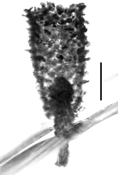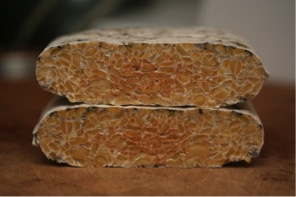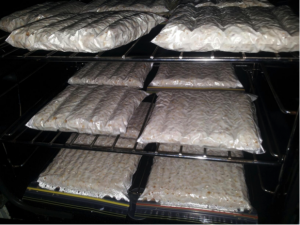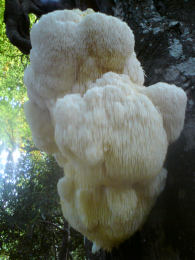By Alissa Overson
Fungus is a common part of our everyday life, whether or not we realize it. From the food in our kitchens, to the mushrooms in our yards, fungus is everywhere. There are about 100,000 species of described fungi, but recent estimates say that there are over 5 million species waiting to be described (Blackwell 2011)! Of those 100,000 known species of fungi, about 17,000 are mushrooms (Blackwell).
Many mushrooms have amazing qualities about them. One particularly interesting mushroom is the polypore Ganoderma applanatum, commonly known as the artist’s conk. Upon first glance, this mushroom might not look like much. It grows out of fallen logs or wounds in trees and forms a shelf-like knob. The top of the cap is pale brown with a white margin that leads into the white underside. Before touched, the pore surface (the underside of the mushroom) is a perfect white color (see fig. 1). After it is touched, the mushroom “bruises” and turns dark brown very quickly, making it easy to draw on! Artists use this mushroom as a canvas to etch beautiful illustrations on (see fig. 2). David Arora, author of Mushrooms Demystified, says that Ganoderma applanatum “makes an excellent medium for etching, or better yet, leaving cryptic messages in the woods”. Because Ganoderma applanatum is a perennial mushroom, a message left on this mushroom might be there for years to come!
Ganoderma applanatum comes in all sorts of shapes and sizes. The mushroom pictured in Figure 1 was found near my home in Hoodsport, Washington, and is about 8 inches long. The pore surface is very flat, and I plan on making a drawing on it eventually. For now, I am letting it stay in the woods because once picked, there is a limited amount of time to draw on it before it will no longer bruise. This is another amazing feature of the fungus. Drawing on a fresh specimen and then drying it will naturally preserve your masterpiece. While this specimen is fairly small, artist’s conk can grow up to 20 inches! Although it is most commonly used as a canvas, the use of Ganoderma applanatum does not stop with artwork.
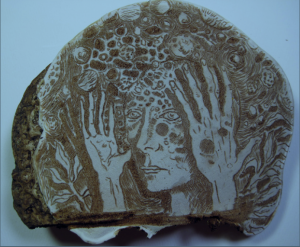
- Fig. 2. Drawing done on G. applanatum by artist Corey Corcoran. Click here to see more!
Ganoderma applanatum is also used for its medicinal properties. The genus Ganoderma is very important to China, which uses many different kinds of these mushrooms in medicine (Jong 1992). While it cannot be directly eaten because it it is too hard, the woody fruiting body can be boiled down into a tea and is used for its antiinflammatory, antitumor, and antibacterial properties. It is also said to help the respiratory system (Stamets 1999). The compounds found in many Ganoderma mushrooms have actually been studied and shown to greatly inhibit tumor growth in mice (Usui et al 1983). This is not just a home remedy!
Many polypores found in the Pacific Northwest are medicinal, and this is just one example. Our forests contain all kinds of fungi, and they can be used in many ways. I think that it is important to keep learning about fungi and how they can be used. Next time you are walking in the woods, keep an eye out for these inconspicuous mushrooms. Maybe you can leave a friendly message for the next hiker, draw a picture, or even harvest the mushroom to make some medicinal tea.
______________________________________
Works Cited
Arora, D. (1986). Mushrooms Demystified. (2 ed., pp. 576577). New York: Ten Speed Press.
Blackwell, M. (2011). The Fungi: 1, 2, 3 .. 5.1 million species? American Journal of Botany, 98(3), 426438.
Jong, S. C., Brimingham, J. M. (1992). Medicinal Benefits of the Mushroom Ganoderma. Advances in Applied Microbiology, 73, 108110.
Stamets, P., & Wu Yao , C. (1999). MycoMedicinals: An Informational Treatise on Mushrooms.
MycoMedia.
Usui, T., Iwasaki, Y., Mizuno, T., Tanaka, M., Shinkai, K., & Arakawa, M. (1983). Isolation and haracterization of antitumor active β glucans from the fruit bodies of Ganoderma applanatum. Carbohydrate Research, 115, 273280.




